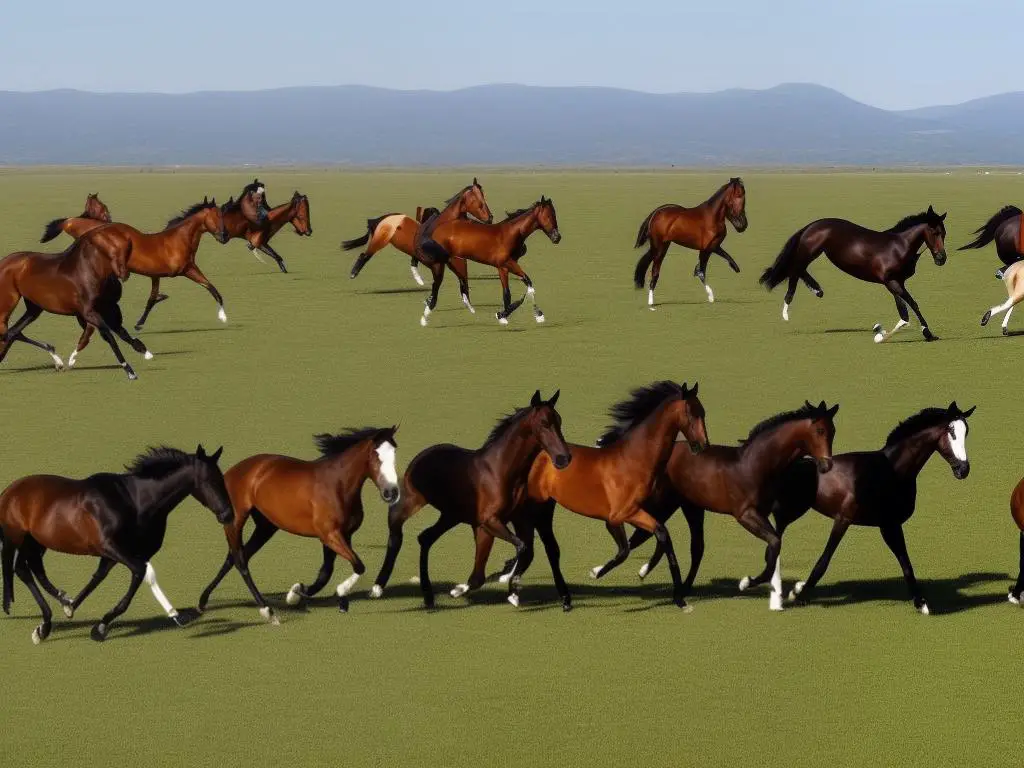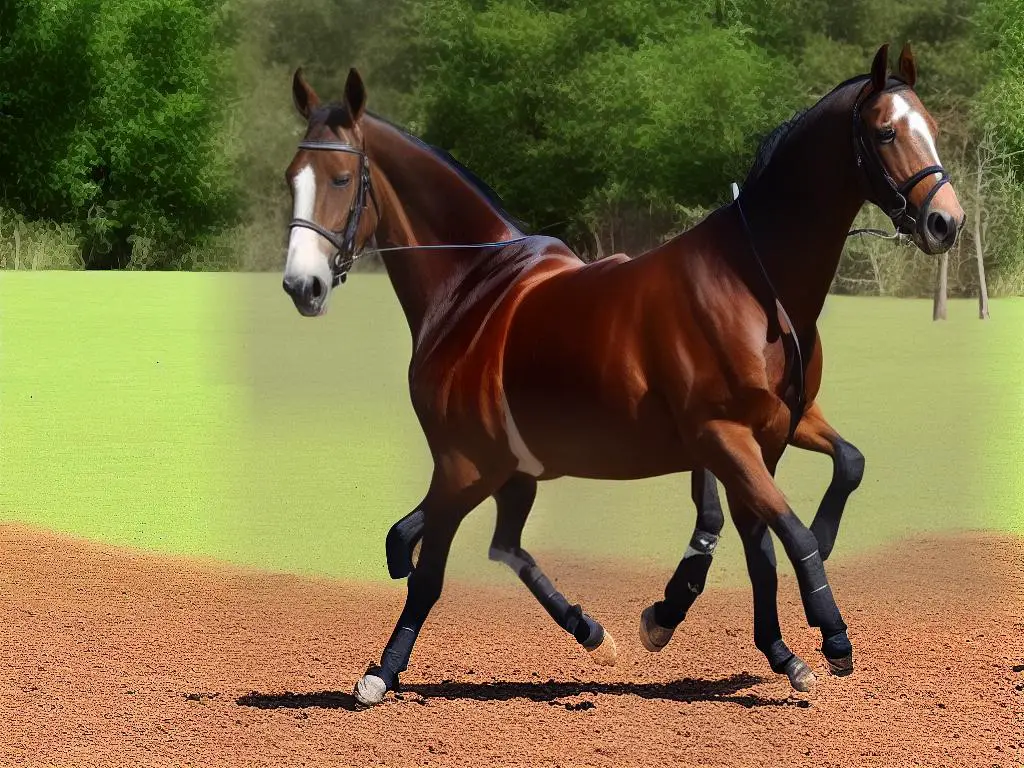Warmblood horses have long been admired for their athleticism, grace, and versatility, making them the top choice for many equestrian enthusiasts and professionals around the world. These horses have a rich history that spans centuries, with origins in various European countries that carefully honed breeding programs to create the exceptional competition horses we know today. Delve into the fascinating world of warmblood horses as we explore their origins and breeding, examine their success in various equestrian disciplines, and discuss the crucial aspects of their training, care, and management.
Table of Contents (Horspedia)
Origins and Breeding of Warmblood Horses
Warmblood Horses
Warmblood horses have a long and fascinating history, originating from various parts of Europe where they were bred for specific purposes, such as agriculture, transportation, and, of course, equestrian sports. Throughout the centuries, the breeding of warmbloods has been refined to create the exceptional sport horses we see today, excelling in various disciplines such as dressage, show jumping, and eventing. In this article, we’ll delve into the origins of warmblood horses, investigate their breed characteristics, and examine the role of breeding in their success in the equestrian world.
Origin of Warmblood Horses
The term “warmblood” refers to a group of middleweight horse breeds that originated in Europe, primarily in countries like Germany, the Netherlands, and Denmark. Warmbloods were developed by crossing “cold blood” draft horses with lighter “hot blood” breeds such as the Arabian, Thoroughbred, and Anglo-Arabian horses. These crosses resulted in a horse that possessed the strength and power of a draft horse but with the elegance, speed, and athleticism required for equestrian sports.
Breed Characteristics
Warmblood horses boast a distinct set of breed characteristics that make them exceptional athletes in various equestrian disciplines. These horses have a well-proportioned and muscular body, a strong and deep chest, and long, elegant legs with strong bone structure. A versatile breed, warmbloods can excel in dressage, show jumping, and eventing, as well as other disciplines such as Hunter/Jumper or even Western riding.
Warmblood horses are also known for their intelligent and willing temperament, making them ideal for both amateur and professional riders alike. They bond well with their human partners, contributing to their high-level performance in the equestrian field.
Breeder Countries and Bloodlines
Over the years, several European countries have emerged as leading breeders of competition warmblood horses, each specializing in producing horses with distinct characteristics and abilities:
- Germany: As the home to several different warmblood breeds, such as the Hanoverian, Oldenburg, and Holsteiner, Germany has long been renowned for its influence on warmblood breeding. These German breeds emphasize power and athleticism, particularly in the disciplines of show jumping and dressage.
- The Netherlands: The Dutch Warmblood, also known as the KWPN (Koninklijk Warmbloed Paardenstamboek Nederland), is a versatile breed that excels in both dressage and show jumping. Known for its elegant movement and powerful jump, the Dutch Warmblood has been consistently successful in international competitions.
- Denmark: The Danish Warmblood has gained fame in the dressage arena, thanks to its elegant movement, natural balance, and aptitude for collection. The breed has produced many top-level dressage horses, such as Blue Hors Matiné, who captured the world’s attention with her freestyle performances at international competitions.
Each of these countries has its own unique breeding programs, with specific goals and guidelines set in place to ensure the continuous improvement of their warmblood breeds. Many breeders and equestrians pay close attention to bloodlines and pedigrees, seeking horses with a proven history of success and exceptional conformation and performance abilities. The influence of top-performing dressage and show jumping sires has been crucial in shaping the future generations of competition warmbloods.
Breeding Competition Warmblood Horses
The intricate process of breeding competition warmblood horses involves a deep understanding of bloodlines, genetics, and desired breed characteristics. The success of these horses in various equestrian disciplines is a testament to the dedication and expertise of breeders, as well as the inherent qualities of the breeds themselves. As equestrian sports continue to evolve and demand even higher levels of performance, the crucial role of breeding in the development of exceptional warmblood horses remains significant.

Equestrian Disciplines for Warmblood Horses
Athleticism and Versatility of Warmblood Horses
Originating in Europe, warmblood horses are a group of middle-weight breeds known for their athleticism, versatility, and good temperament. These qualities make them a popular choice for a variety of equestrian disciplines. Some of the various competitions where warmblood horses excel include dressage, show jumping, and eventing. This article will explore the unique challenges and requirements of each discipline, and explain why warmblood horses are particularly well-suited for these events.
Dressage
Dressage is an equestrian sport in which the horse and rider perform a series of predetermined movements, showcasing the horse’s training, obedience, and balance. The main goal of dressage is to improve the horse’s natural athleticism and their ability to work in harmony with their rider. Warmblood horses, such as Dutch Warmbloods and Hanoverians, are particularly well-suited for dressage because of their natural balance, fluid movement, and willingness to work with their rider.
Dressage competitions are judged on the horse’s correctness, fluidity, and harmony with its rider. Horses must demonstrate a high level of suppleness, balance, and responsiveness without resistance. The warmblood horse’s innate traits, such as their powerful and flowing gaits combined with a natural willingness to please their rider, make them ideal candidates for dressage success.
Show Jumping
In show jumping, horse and rider must navigate a course of jumps, aiming to clear each one without knocking down any rails or accruing any penalties. Warmblood horses, such as Belgian Warmbloods and Holsteiners, are favored in this discipline because of their athleticism, power, and agility.
Warmblood horses are known for their strong hindquarters, which provide the power necessary to jump great heights with precision and accuracy. Their naturally calm and trainable temperament also attribute to their success in show jumping, as they can easily adapt to the technical demands and pressure of the sport.
Eventing
Eventing is an equestrian discipline that combines the three phases of dressage, cross-country, and show jumping. The sport is designed to test the overall athleticism, endurance, and versatility of both horse and rider. Warmblood horses, such as Irish Sport Horses and Trakehners, are particularly well-suited for eventing because of their ability to excel in each of the three phases.
In eventing, a horse must be able to demonstrate grace and harmony in the dressage phase, boldness and stamina in the cross-country phase, and precision in show jumping. Warmblood horses’ natural balance and fluid movement make them strong contenders in dressage, while their power and agility aid in the jumping phases. Their brave and willing temperaments are also an asset in eventing, as they are often required to navigate challenging natural obstacles in the cross-country phase.
Introduction to Warmblood Horses
Warmblood horses are a versatile and athletic group of breeds that excel in various equestrian disciplines, such as dressage, show jumping, and eventing. Their natural balance, fluid movement, and willing temperament make them ideal candidates for these sports, as they can easily adapt to the unique challenges and requirements of each discipline. Equestrians seeking a horse capable of succeeding in multiple disciplines should consider a warmblood as an excellent option for competitive success.

Training, Care and Management of Competition Warmbloods
Warmblood Horse Care and Management
These special category breeds, when given the proper training, nutrition, and healthcare, can truly excel in various equestrian disciplines, from dressage to show jumping and eventing. Their talent, grace, and power shine the brightest when they receive proper care and attention. To ensure that these majestic animals perform their best and maintain their overall well-being, their caretakers should adhere to essential practices of training, care, and management.
Training Regimes for Competition Warmbloods
A comprehensive training regime is a crucial aspect of preparing warmblood horses for peak performance in competitions. The foundation of an effective training program lies in developing the horse’s capability to produce balanced movements while carrying a rider. In the early stages of training, lunging and groundwork exercises can be introduced to help the horse achieve balance and understand basic aids before carrying a rider.
It’s crucial to gradually intensify their training as their strength and understanding develop. As they progress, warmbloods should be exposed to various gaits, transitions, and lateral movements that correspond to their discipline. Consistency and patience throughout the training process are vital in keeping the horse engaged and ensuring a positive learning experience.
Cross-training and appropriate rest periods are essential for avoiding physical and mental fatigue. Horses benefit from a combination of lessons, hacking, and field turnout, which helps them stay motivated and less prone to injuries. Consistent monitoring of the horse’s performance, condition, and temperament will enable the rider and trainer to make necessary adjustments to the training program for optimal results.
Nutritional Requirements for Warmbloods
Proper nutrition is key to maintaining a competition warmblood’s health, condition, and performance. The diet should be balanced, containing the right amount of protein, energy, vitamins, and minerals to support the horse’s needs during training and competition. A forage-based diet comprised of good quality hay or pasture should make up the majority of a competition warmblood’s nutritional intake, ensuring adequate fiber levels.
Supplementary concentrates may be necessary to provide additional energy to meet the increased demands of training and competition, but should be introduced carefully to avoid overfeeding and its related issues. Supplements can be tailored to the horse’s specific needs, addressing areas such as joint support, digestive health, and coat condition.
A constant supply of clean, fresh water is also vital for the horse’s well-being. Proper hydration helps maintain peak performance and aids in recovery after intensive training or competition.
Healthcare and Veterinary Care for Warmbloods
Regular veterinary care is of utmost importance in upkeeping the health and fitness of competition warmbloods. A schedule of routine vaccinations, deworming, and dental care should be in place to minimize the risk of illness and maximize comfort.
In addition to routine care, horses should be carefully monitored for signs of injuries, stress, or illness. Collaboration among trainers, riders, and veterinarians is essential to detect any changes in the horse’s condition early on, allowing for prompt treatment and minimizing potential long-term complications.
Timely farrier appointments are essential to maintain balanced, healthy hooves. Correct shoeing and hoof care are crucial in preventing lameness and optimizing the horse’s overall performance.
Conclusion
Performance warmbloods require diligent attention to their training, nutrition, and healthcare to unleash their full potential and maintain their welfare. By dedicating time and effort, we can ensure that these magnificent animals enjoy a healthy, successful life in and out of competition.

With their rich history, unique breeding, and incredible aptitude for various equestrian disciplines, it is clear that warmblood horses are truly exceptional animals. Their powerful yet elegant presence has captivated the hearts of many, and their legacy continues to grow as dedicated breeders, trainers, and riders work together to ensure their continued success in the world of competitive equestrian sports. Furthermore, understanding and implementing proper training, care, and management practices are essential for the well-being and optimal performance of these magnificent horses, highlighting the importance of collaboration and knowledge sharing within the equestrian community.